Screen mirroring is a technology that clones the content of one screen to another screen via a wireless network. If your two devices, say smartphone and TV, support screen mirroring technology, you can easily stream media from your smartphone to television. By using this technology, you can also cast your computer screen to another supported device. But for this, you have to install Wireless Display on your computer. This post will guide you on how to add and remove the Wireless Display feature in Windows 11/10.
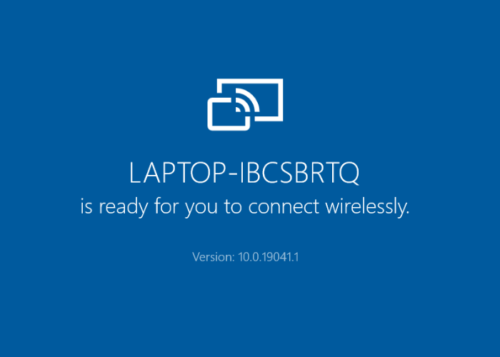
Add or remove Wireless Display feature in Windows 11/10
We will describe how to install and uninstall this feature in Windows 10 by using:
- Settings app.
- Command Prompt.
You can install and uninstall this feature only if you are signed in as an Administrator. One more thing that you should note here is your system’s screen can only be projected to the device that is on the same wireless network.
1] Using the Settings app
Windows 11
The steps to add and remove the Wireless Display feature in Windows 11 are slightly different from those in Windows 10 OS. First, we will discuss the procedure for installing the feature. Then, we will see how to uninstall it.
The following instructions will help you install the Wireless Display feature on your Windows 11 computer:
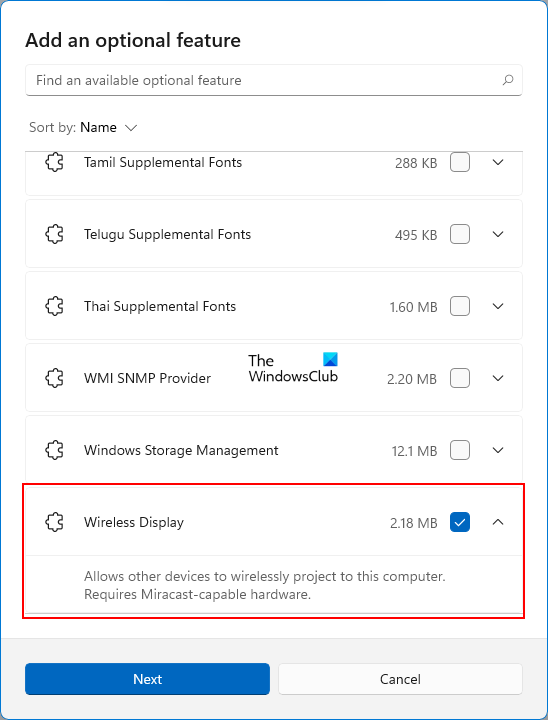
- Press Win + I keys to launch the Windows 11 Settings app on your system.
- In the Settings app, select Apps from the left pane.
- Now, click on the Optional features tab on the right side.
- To add Wireless Display, click on the View features button next to the Add an optional feature tab. You will then see a list of all optional features arranged in alphabetical order. Now, scroll down the list and locate Wireless Display. Once you find it, select it and click on the Next button.
- Now, click on the Install button.
Now, let’s see the steps to uninstall or remove the Wireless Display feature from Windows 11.
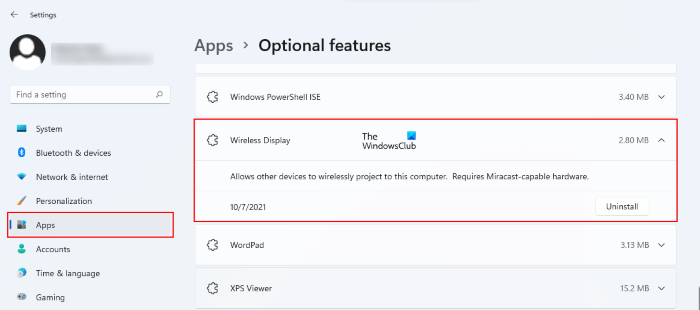
- Launch the Settings app on your computer.
- Go to “Apps > Optional features.”
- On the Optional features page, you will see the list of all the features added to your system under the Installed features section. Scroll down the list and locate Wireless Display. Alternatively, you can also use the search box in the Installed features section to find the Wireless Display feature. Once you find it, click on the down arrow to expand it.
- Now, click on the Uninstall button.
Windows 10
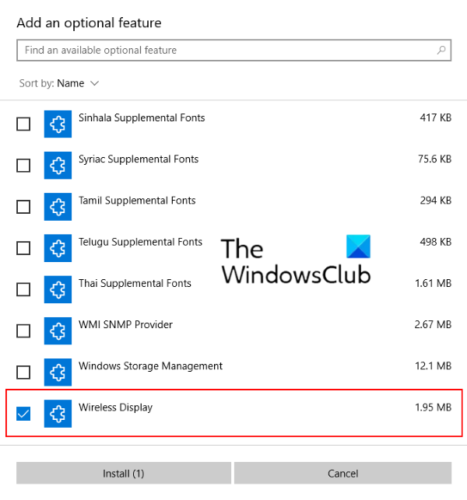
The following instructions will help you install this feature:
- Open the Windows 10 Settings app click on Apps.
- In the Apps & features section, click on the Optional features.
- Now, click on Add a feature. This will open a new window.
- Scroll down the list to find the Wireless Display. Select it and click on the Install button.
It will take some time to install. After the installation gets completed, the Wireless Display will be added to the Start menu as a Connect app. Now, your system is ready to connect with another display wirelessly.
To uninstall the Wireless DIsplay feature in Windows 10, repeat the first two steps listed above and scroll down the list of apps shown in the Optional features. Click on the Wireless Display and click Uninstall. It will take some time to uninstall.
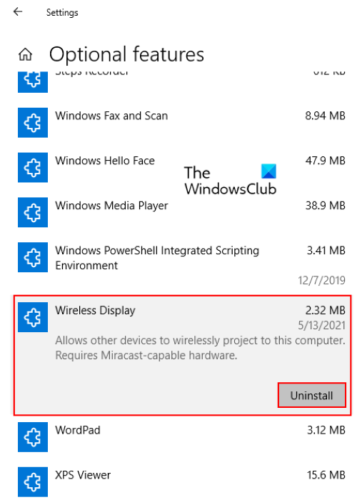
Read: How to use Microsoft Wireless Display Adapter.
2] Via Command Prompt
Before you begin, make sure that your computer is connected to the internet.
To install Wireless Display via the Command Prompt, open the Command Prompt as an Administrator. Copy the following command, paste it there, and press Enter.
DISM /Online /Add-Capability /CapabilityName:App.WirelessDisplay.Connect~~~~0.0.1.0
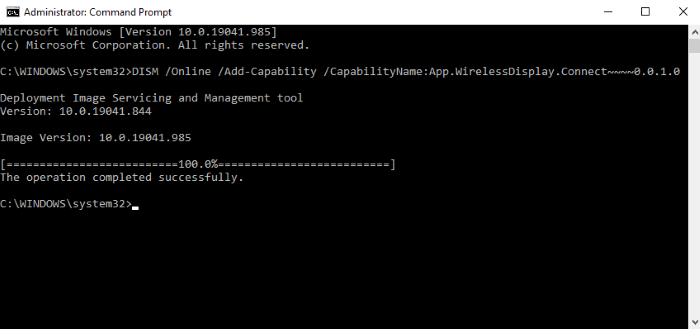
While installing this feature you can see the progress in the Settings app. After the installation gets completed, you will get a message ‘The operation completed successfully.’
If you get an Install failed message in the Command Prompt, check whether there is any update pending on your system and install it if available. I received the error message while installing Wireless Display via an elevated Command Prompt. After that, I updated my system and the issue was fixed.
To uninstall Wireless Display in Windows 10 via cmd, launch the Command Prompt as an Administrator. Copy and paste the following command in it and hit Enter.
DISM /Online /Remove-Capability /CapabilityName:App.WirelessDisplay.Connect~~~~0.0.1.0

After uninstalling gets completed, restart your computer if you are asked to do so.
How do I delete Wireless Display?
You can delete the Wireless Display from your Windows 11/10 computer by uninstalling it either from the Settings app or by executing a command in the Command Prompt. This article explains the entire procedure above.
Why Wireless Display is not installing?
You may receive an install failed error while adding the Wireless Display feature to your Windows 11/10 computer. There could be many causes of this error, like unstable internet connection, you are on a metered connection, etc. Sometimes, a restart fixes the problems on a Windows device. Therefore, first, restart your computer and see if it helps. You should also check whether or not there is any pending update. If yes, install it and then check if you are still receiving the Wireless display install failed error message.
Does Windows Home support Wireless Display?
Windows 11/10 Home supports the Wireless Display feature. Because it is an optional feature in Windows OS, it may or may not be installed on your system. If you do not find it on your computer, you have to install it via Windows Optional features. We have explained the procedure for the same above in this article.
Related posts: